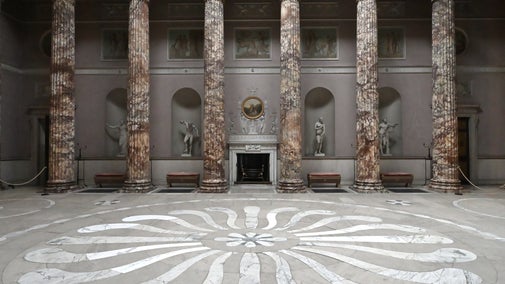
Discover more at Kedleston Hall
Find out when Kedleston Hall is open, how to get here, things to see and do and more.

Kedleston Hall showcases the power of art and design. Built by Nathaniel Curzon, 1st Baron Scarsdale, to innovative designs by the young Robert Adam, the Hall was intended to pay homage to ancient Greece and Rome. The result is one of the most convincing and best-preserved expressions of classical architecture in Britain. Read on to discover the history behind Kedleston Hall.
Completed under the watchful eye of famous architect Robert Adam, Kedleston Hall was built for Sir Nathaniel Curzon between 1759 -1765 as a house to rival Chatsworth. Intended as 'a temple of the arts' and as the location for grand entertainments, the main Hall was built as a space to showcase the finest paintings, sculpture and furniture. It was also used for grand entertainment and a ‘place to see’ for country house visitors.
The Curzons came to Britain from Normandy at the time of William the Conqueror and we estimate that they have been at Kedleston since the 1150s. The property boasts a number of portraits and pedigrees detailing the succession of such a long-standing family. The Hall we see today replaced an earlier medieval house and village of slightly more modest proportions.
Kedleston Hall was always intended as a showpiece rather than a comfortable family home; in fact, the family has lived in the private family wing and still do to this day. The central block was a largely uninhabited entertaining space with the servants' quarters and service areas housed in the West Wing. What is now the restaurant was once the Great Kitchen, catering for the Curzon family's great banquets and dinner parties.

The first floor was used but never lived in by the family. It was built to wow guests with lavish details and luxurious surroundings and reflects the austere grandeur of a show palace.
Over 30 years, the State Floor has been restored to reflect architect Robert Adam's original vision for Kedleston. Original painting schemes were reintroduced, and restoration work was completed on gilt furniture and artworks, returning the rooms to their 18th-century glory.
The contents of the state floor were also part of Robert Adam's vision. He worked closely with talented craftspeople to produce what are now considered some of the finest examples of 18th-century craftsmanship. There are fine examples of furniture commissioned exclusively for the Hall by Robert Adam for Sir Nathaniel Curzon.
The ground floor was designed to be a more functional space and was used as an everyday entrance. In the late 1920s, Lord Curzon created a museum on the ground floor which holds one of the largest Asian collections in the Midlands, and one of the most significant within the National Trust.

Also on the ground floor is a Museum of Asian artefacts with over 1,000 objects from across the Asian continent. This collection was brought together by George Nathanial Curzon, 1st Marquess Curzon of Kedleston (1859-1925) who inherited the Hall in 1916. Curzon travelled extensively across Asia and in 1899 became the Viceroy of India, making him the highest British representative in colonial India.
In his will of 1925, he divided the collection between the Victoria & Albert Museum and a museum to be created at Kedleston.

Find out when Kedleston Hall is open, how to get here, things to see and do and more.
The Curzons are long-standing inhabitants of Kedleston Hall. Learn about the political career of Lord Curzon and the work undertaken in women’s health by his wife Mary.

Visit the Hall at Kedleston, which is a prime example of 18th-century Palladian and Neoclassical inspired architecture and the ancestral residence of the Curzon family.

Find out how the team at Kedleston Hall have been working to protect and conserve Kedleston Hall’s objects and collections, from books to the 18th-century floor.

The parkland at Kedleston was created to complement the magnificence of the hall. Learn how the vision of a landscaped park and pleasure grounds came to life.

Read our report on colonialism and historic slavery in the places and collections we care for and discover how we’re changing the way we approach these issues.

Learn about people from the past, discover remarkable works of art and brush up on your knowledge of architecture and gardens.

Explore the objects and works of art we care for at Kedleston Hall on the National Trust Collections website.
